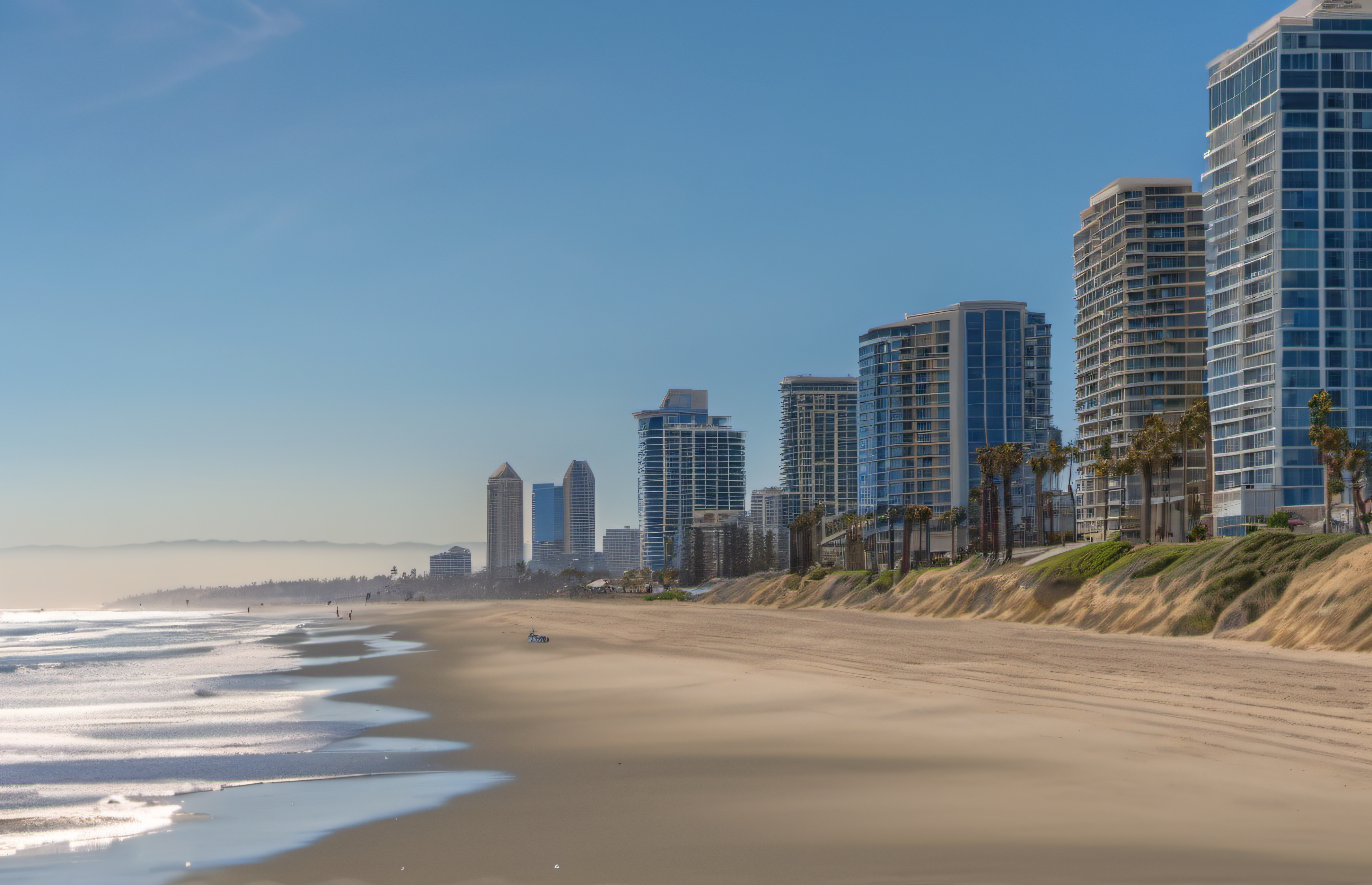The Ultimate Seller’s Guide to San Diego
Table of Contents
- Introduction
- Preparing Your Home for Sale
- Understanding the Selling Process
- Disclosures and Legal Obligations
- Reviewing Offers and Negotiating
- Closing the Deal
- Protecting Yourself as a Seller
- Local Insights for San Diego Sellers
- Conclusion
Introduction
Selling real estate in San Diego means navigating a vibrant and competitive market. As one of California’s most desirable regions, San Diego attracts buyers from across the globe seeking its coastal lifestyle, diverse neighborhoods, and booming economy.
With its mix of historic charm, modern communities, and luxury properties, San Diego offers unique opportunities for sellers. This guide is designed to give you the insights and tools you need to showcase your home, negotiate effectively, and achieve a successful sale. Whether you’re selling a beachside bungalow in La Jolla, a family home in Poway, or a condo in Downtown San Diego, this guide will help you maximize your property’s potential and protect your interests throughout the process.
Preparing Your Home for Sale

Preparing your home for sale in San Diego means aligning your property with the lifestyle buyers seek—an emphasis on outdoor living, energy efficiency, and thoughtful design. The steps you take to showcase your home can greatly impact its marketability and sale price.
Staging and Presentation
First impressions are everything in San Diego’s highly competitive real estate market. Here’s how to make your home stand out:
- Enhance curb appeal: Many buyers in San Diego prioritize curb appeal. Invest in low-maintenance, drought-resistant landscaping like succulents or native plants. A fresh coat of exterior paint in coastal-inspired tones can also elevate your property’s exterior.
- Showcase outdoor living spaces: Given San Diego’s year-round sunshine, buyers are drawn to outdoor amenities. Stage patios with cozy seating, set up a grill in your backyard, or highlight a fire pit to help buyers envision entertaining or relaxing outdoors.
- Maximize natural light: San Diego buyers value bright, airy spaces. Replace heavy curtains with sheer window treatments, clean all windows, and ensure light fixtures are modern and functional to enhance the home’s brightness.
- Declutter and depersonalize: Make it easy for buyers to picture themselves living in your home. Pack away personal photos, minimize furniture, and opt for neutral décor to create a universally appealing space.
- Focus on updates that matter: San Diego buyers often appreciate modern kitchens and bathrooms. If your budget allows, consider upgrading appliances, installing energy-efficient fixtures, or refreshing countertops and backsplashes.
Setting the Right Price
Pricing your home accurately is a critical step in ensuring a fast and profitable sale in San Diego’s competitive market. Here’s how to set your price:
- Research local trends: Pricing varies significantly across neighborhoods. Luxury homes in La Jolla or Del Mar often command premium prices, while properties in Clairemont or Mission Valley cater to more budget-conscious buyers. Examine recent comparable sales (comps) in your specific area.
- Highlight unique selling points: Homes near San Diego’s beaches, top-rated schools, or vibrant urban hubs like Little Italy can justify higher prices. Consider these factors when setting your price.
- Factor in energy-efficient upgrades: Buyers in San Diego often value solar panels, tankless water heaters, and other eco-friendly features. These upgrades can be a strong selling point that supports a higher price.
- Consult a professional: An experienced local real estate agent will provide a detailed comparative market analysis (CMA) and help you avoid the risks of overpricing or underpricing your home.
By aligning your home with San Diego buyers’ expectations and setting a competitive price, you’ll position your property for success. The effort you put into preparation will ensure your home attracts the right offers and stands out in a crowded market.
Understanding the Selling Process

Selling a home in San Diego requires navigating several key steps, each designed to ensure a seamless and successful transaction. From signing a listing agreement to understanding market conditions, being well-informed is essential.
Listing Agreements
The first step in the selling process is partnering with a real estate professional and formalizing your relationship through a listing agreement. Here’s what you need to know:
- Seller Net Sheet: This document breaks down the estimated net proceeds from your home sale after deducting agent commissions, closing costs, and other fees. Reviewing this early helps set realistic financial expectations.
- Pricing Strategy: Collaborate with your agent to develop a pricing strategy tailored to your property and its location. An accurate pricing approach is crucial in San Diego’s competitive market, where factors like proximity to beaches, schools, and entertainment hubs play a significant role in home values.
Timeline Overview
The time it takes to sell a home in San Diego can vary based on market dynamics, property type, and location. Here are some key factors that influence the timeline:
- Seasonal Demand: Spring and early summer are typically the most active periods for home sales in San Diego. These seasons attract buyers looking to move before the new school year or take advantage of favorable weather for home tours.
- Market Conditions: In a balanced market, homes in San Diego usually sell within 30–60 days. However, properties in high-demand areas like Pacific Beach, Carmel Valley, or Mission Hills may sell more quickly, sometimes within weeks or even days.
- Preparation and Marketing: The amount of time you spend preparing your home for sale—such as staging, making repairs, and launching a marketing campaign—can also impact the overall timeline.
Pro Tip: Homes priced competitively and marketed effectively are more likely to attract multiple offers and sell faster, even in less active seasons.
By understanding the steps involved in the selling process and working closely with a knowledgeable real estate professional, you can streamline your transaction and achieve your desired outcome in San Diego’s dynamic housing market.
Disclosures and Legal Obligations

In California, sellers are legally required to disclose all known material facts about their property. These disclosures not only ensure compliance with the law but also help build trust with potential buyers, reducing the likelihood of disputes or delays in the sale process.
Key Documents
Providing complete and accurate documentation is essential. Below are the primary disclosure documents required for selling a home in San Diego:
-
Transfer Disclosure Statement (TDS):
This document outlines the condition of the property, including structural elements, systems, and any known defects. Be thorough and transparent when completing the TDS to avoid potential liability. -
Natural Hazard Disclosure (NHD):
This report identifies whether your property is located in a natural hazard zone, such as a floodplain, high wildfire risk area, or earthquake fault zone. In San Diego, wildfire and earthquake risks are particularly common, so buyers will expect detailed information. -
HOA Documents:
If your property is part of a homeowners association (HOA), you must provide the buyer with governing documents such as bylaws, CC&Rs (Covenants, Conditions, and Restrictions), financial statements, and meeting minutes. Buyers will want to understand HOA rules, fees, and any pending assessments.
Additional Considerations
-
Local Requirements:
Depending on your property’s location in San Diego, there may be additional disclosure requirements, such as noise considerations for homes near airports (e.g., San Diego International Airport or MCAS Miramar) or properties close to major highways. -
Pre-Sale Inspections:
While not required, obtaining a pre-sale home inspection can help identify potential issues early. Addressing these proactively allows for more accurate disclosures and may prevent surprises during the buyer's inspection.
Pro Tip: Accuracy and honesty in disclosures are your best defenses against post-sale disputes. A buyer who feels well-informed is less likely to challenge the transaction later.
By adhering to California’s disclosure laws and providing complete documentation, you can protect yourself legally and create a smoother, more transparent selling process.
Reviewing Offers and Negotiating

Reviewing offers in San Diego’s competitive market involves looking beyond the purchase price to assess the terms and conditions that could impact the overall success of the transaction. Thoughtful evaluation and strategic negotiation are key to securing the best deal.
Key Factors to Consider
-
Contingencies:
Contingencies are conditions that must be met for the sale to close. Common contingencies include:-
Financing: Ensures the buyer secures a loan. While common, financing contingencies can add time and uncertainty to the process.
-
Inspection: Allows the buyer to assess the property’s condition and request repairs or credits. Be prepared for negotiations based on inspection findings.
-
Appraisal: Ensures the property’s value matches or exceeds the loan amount. In a competitive market like San Diego, appraisal gaps can occur, where the appraisal is lower than the offer price.
Pro Tip: Offers with fewer contingencies often carry less risk, making them more attractive to sellers.
-
-
Cash Offers:
Cash offers are often preferred in San Diego due to their speed and reliability. Without the need for loan approval, these offers typically involve fewer contingencies and can close faster. However, don’t automatically accept a lower cash offer without considering the total package. -
Earnest Money Deposit (EMD):
A higher EMD demonstrates a buyer’s commitment to the purchase. In San Diego, an EMD of 2-3% of the purchase price is standard, but motivated buyers may offer more to stand out. -
Buyer’s Flexibility:
Consider factors like the buyer’s willingness to accommodate your desired timeline for moving or their readiness to waive certain contingencies. These elements can make an offer more appealing beyond the monetary value.
Negotiation Strategies
Once you’ve reviewed the offers, negotiating terms to align with your priorities is crucial:
- Repairs and Credits:
If the buyer requests repairs, offering a credit instead can save time and simplify the process. This allows the buyer to handle repairs according to their preferences after closing. - Appraisal Gaps:
In a hot market, buyers may offer above asking price but face appraisal challenges. Negotiate terms where the buyer agrees to cover any difference between the appraisal and the purchase price. - Backup Offers:
Keeping a strong backup offer in place ensures you have a fallback option if the primary deal falls through.
Reminder: Negotiations are about finding a balance between achieving your goals and accommodating the buyer’s needs. Flexibility and clear communication often lead to better outcomes.
Evaluating offers with a holistic approach and negotiating effectively can maximize your sale’s success. A trusted real estate professional can guide you through this process, ensuring you make informed decisions that align with your priorities.
Closing the Deal

The final steps in selling your San Diego home are critical to ensuring a smooth and successful closing. By staying organized and proactive, you can navigate this phase with confidence.
Inspections and Appraisals
Inspections and appraisals are key components of the closing process. Addressing these steps efficiently helps maintain buyer confidence and ensures the transaction moves forward without unnecessary delays.
-
Inspections:
Buyers typically conduct a home inspection to assess the property’s condition. Common areas of focus in San Diego include roofing, plumbing, electrical systems, and HVAC performance. Homes near the coast may also require additional inspections for saltwater-related wear or termite damage.- Be proactive: Consider getting a pre-inspection before listing your home. This allows you to address potential issues ahead of time and disclose them accurately.
- Negotiate smartly: If inspection findings lead to repair requests, you can choose to offer credits, make necessary fixes, or negotiate terms that align with your priorities.
-
Appraisals:
The buyer’s lender will require an appraisal to confirm the property’s value aligns with the loan amount. In competitive areas like La Jolla or Del Mar, it’s not uncommon for offers to exceed the appraised value.- Appraisal gaps: If the appraisal comes in lower than the agreed-upon price, you may need to renegotiate or consider alternative solutions, such as a buyer agreeing to cover the gap.
Pro Tip: Homes in desirable neighborhoods or with unique features are often in high demand. Ensuring these details are emphasized during the appraisal can help justify a higher value.
Escrow Process
Escrow is where the legal and financial details of the sale are finalized. Working closely with your escrow officer ensures a seamless closing.
-
Key Documents:
- Signed disclosures and agreements
- Proof of repairs, if applicable
- Payoff information for any outstanding loans or liens on the property
-
Timeline:
In San Diego, escrow typically lasts 30 to 45 days, though cash transactions may close faster. Adhering to deadlines for inspections, appraisals, and document submissions is essential to avoid delays. -
Final Walkthrough:
Buyers will conduct a final walkthrough to ensure the property is in the agreed-upon condition. Make sure the home is clean, repairs are completed, and agreed-upon fixtures are intact.
Reminder: Communication with all parties—your agent, the buyer’s agent, and the escrow officer—is critical during this stage. Respond promptly to requests for documents or signatures to keep the process on track.
Closing Day
On the day of closing:
- Confirm that all funds, including the buyer’s payment and your mortgage payoff, have been received and disbursed.
- Transfer ownership by signing the deed and providing any necessary keys or access codes to the buyer.
- Celebrate! Your sale is complete.
Closing a home sale in San Diego requires attention to detail and collaboration with experienced professionals. With proper preparation, you can ensure a smooth process and a successful transition to the next chapter.
Local Insights for San Diego Sellers
San Diego’s diverse neighborhoods cater to a wide range of buyers, each with their own priorities and preferences. Understanding what makes your community appealing can help you market your home effectively.
Coastal Communities
San Diego’s coastal neighborhoods are among the most desirable in Southern California, attracting buyers who value beachside living and outdoor activities.
- Key Features:
- Proximity to the beach, boardwalks, and ocean views.
- Access to outdoor activities like surfing, kayaking, and biking.
- Vibrant dining and shopping options in areas like La Jolla, Pacific Beach, and Del Mar.
- Buyer Appeal:
These areas often attract professionals, retirees, and second-home buyers looking for luxury or a relaxed coastal lifestyle.
Urban Living
Downtown San Diego and its surrounding urban neighborhoods, like Little Italy, East Village, and Bankers Hill, are ideal for buyers seeking walkability and convenience.
- Key Features:
- Close proximity to cultural attractions, nightlife, and dining.
- Easy access to major employers and public transportation.
- High-rise condos with modern amenities and panoramic views.
- Buyer Appeal:
Urban areas are popular with young professionals, empty nesters, and investors seeking rental properties.
Family-Friendly Suburbs
San Diego’s suburban communities, such as Poway, Encinitas, and Scripps Ranch, offer a quieter lifestyle with amenities tailored to families.
- Key Features:
- Top-rated schools, large parks, and community centers.
- Spacious homes with yards and family-oriented layouts.
- Safe, well-maintained neighborhoods.
- Buyer Appeal:
Suburban areas attract families looking for excellent school districts, outdoor recreation, and a sense of community.
Unique Neighborhood Highlights
- North County Coastal: Areas like Carlsbad and Oceanside offer a mix of coastal charm and affordability compared to La Jolla or Del Mar.
- Mission Hills and Hillcrest: Known for their historic homes and eclectic vibe, these neighborhoods attract buyers looking for character and proximity to the city.
- East County: Communities like El Cajon and La Mesa provide a more affordable option for buyers while still offering easy access to downtown and beaches.
Pro Tip: Tailor your marketing to highlight the features that resonate most with your neighborhood’s target buyer. For example, emphasize a home’s proximity to the beach in coastal areas or its walkability and nightlife access in urban neighborhoods.
By leveraging these local insights, you can position your San Diego home to attract the right buyers and achieve a successful sale. Each neighborhood’s unique character offers an opportunity to showcase your property’s standout features.
Final Steps to Success
Selling your home in San Diego is an exciting opportunity to capitalize on one of the most dynamic real estate markets in California. By carefully preparing your property, understanding local market trends, and working with a trusted real estate professional, you can navigate the process with confidence and achieve your goals.
For personalized guidance, a competitive market analysis, and expert support every step of the way, connect with your San Diego real estate expert today. Together, we can turn your selling journey into a seamless and rewarding experience.
